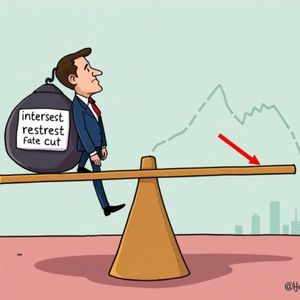Fed Rate Cut Hopes Dim: Odds Plummet Below 50% for September
9 min read
BitcoinWorld Fed Rate Cut Hopes Dim: Odds Plummet Below 50% for September The world of finance, particularly the volatile cryptocurrency market, often hangs on every word and data point released by central banks. Lately, all eyes have been on the United States Federal Reserve and the shifting probabilities of a Fed rate cut . What was once a strong possibility for September has now taken a dramatic turn, sending ripples of uncertainty across global markets. Just recently, traders were pricing in a more than 60% chance of a Fed rate cut by September. However, in a swift and notable shift, this optimism has evaporated. According to the widely watched CME FedWatch Tool, the odds of the Federal Reserve implementing a rate reduction in September have plummeted to below 50%. This significant recalibration of expectations, occurring just ahead of a crucial Federal Open Market Committee (FOMC) meeting, signals a potentially prolonged period of higher interest rates. But what exactly does this mean for investors, the broader economy, and especially for your crypto portfolio? Understanding the Shift in Fed Rate Cut Expectations To grasp the magnitude of this shift, it’s essential to understand the tools and metrics markets use. The CME FedWatch Tool is a real-time tracker that gauges the probability of various Fed policy actions, primarily interest rate changes, based on fed funds futures contract prices. It’s essentially the market’s collective bet on what the Fed will do next. The Dramatic Drop: The move from over 60% probability to less than 50% for a September Fed rate cut in a single day is not a minor fluctuation. It indicates a fundamental re-evaluation by traders regarding the Fed’s likely path. FOMC Meeting Influence: This change occurred directly in the run-up to an FOMC meeting, where the Fed typically releases its latest economic projections and Chair Jerome Powell holds a press conference. Markets are often highly sensitive to any hints or subtle changes in tone from these events. Market Front-Running: Traders don’t wait for the Fed to act; they try to anticipate. This sudden drop in probability suggests that recent economic data, combined with potential insights or leaks ahead of the FOMC, have led the market to believe the Fed will maintain its hawkish stance for longer than previously thought. This isn’t just about a single month; it reflects a broader sentiment that the conditions for easing monetary policy might not be materializing as quickly as some had hoped. The implications for borrowing costs, corporate earnings, and asset valuations are substantial. Why are Fed Rate Cut Chances Diminishing? The Federal Reserve’s decisions are data-dependent, focusing primarily on its dual mandate: achieving maximum employment and maintaining price stability (controlling inflation). Several key factors are likely contributing to the diminishing prospects of a near-term Fed rate cut : Persistent Inflation: Despite some cooling, inflation remains stubbornly above the Fed’s 2% target. Recent Consumer Price Index (CPI) and Producer Price Index (PPI) reports have shown prices rising more than anticipated, signaling that the battle against inflation is far from over. The Fed needs clear, consistent evidence that inflation is sustainably moving towards its target before considering cuts. Robust Labor Market: The U.S. labor market has shown remarkable resilience. Unemployment rates remain low, and wage growth, while moderating, is still strong enough to potentially fuel inflationary pressures. A strong job market gives the Fed less urgency to cut rates to stimulate economic activity. Hawkish Rhetoric: Several Fed officials have recently reiterated a “higher for longer” stance, emphasizing that they are prepared to keep interest rates elevated until they are confident inflation is under control. This messaging reinforces the idea that the Fed is in no rush to ease policy. Economic Resilience: The U.S. economy has largely defied predictions of a recession, showing surprising strength in various sectors. This resilience means the Fed doesn’t feel compelled to provide monetary stimulus to prevent an economic downturn. These factors collectively paint a picture of an economy that is still running warm, allowing the Fed to maintain restrictive monetary policy without immediately risking a severe economic contraction. This cautious approach is aimed at ensuring inflation is truly tamed, even if it means delaying a much-anticipated Fed rate cut . What Does This Mean for the Cryptocurrency Market? The relationship between traditional monetary policy and the volatile world of cryptocurrencies is complex but generally follows a pattern: tighter money supply and higher interest rates tend to be bearish for risk assets, including digital currencies. Liquidity Squeeze: When interest rates are high, holding cash or traditional fixed-income assets (like bonds) becomes more attractive. This reduces the incentive for investors to seek higher returns in riskier, more speculative assets like Bitcoin and altcoins. Less liquidity flowing into crypto can lead to price stagnation or declines. Risk-Off Sentiment: In an environment of economic uncertainty and higher borrowing costs, investors typically adopt a “risk-off” mentality. They move capital away from volatile assets and towards safer havens. Cryptocurrencies, despite their growing institutional adoption, are still largely perceived as high-risk investments. Impact on Innovation and Growth: Higher interest rates also increase the cost of capital for crypto projects and blockchain startups. This can slow down innovation, development, and expansion within the industry, as funding becomes more expensive and harder to secure. Increased Volatility: The market’s reaction to the falling odds of a Fed rate cut can trigger significant price swings. Traders may liquidate positions or open new ones based on these macro shifts, leading to heightened volatility in Bitcoin, Ethereum, and other cryptocurrencies. While Bitcoin’s halving events and growing institutional interest provide some counter-narrative, the overarching macroeconomic environment, heavily influenced by the Fed’s stance, remains a powerful determinant of crypto market sentiment and price action. A prolonged period without a Fed rate cut could test the resilience of the crypto market. Navigating the Uncertainty: Strategies for Investors in a Higher-for-Longer Environment Given the current economic outlook and the diminishing prospects of an immediate Fed rate cut , how can cryptocurrency investors best position themselves? Adapting your strategy to a “higher for longer” interest rate environment is crucial for navigating potential volatility and safeguarding your investments. Embrace a Long-Term Perspective: Short-term market fluctuations driven by macroeconomic news can be jarring. However, focusing on the long-term fundamentals of blockchain technology and specific projects can help weather the storm. Many believe in the transformative potential of crypto regardless of immediate rate decisions. Dollar-Cost Averaging (DCA): Instead of trying to time the market, which is notoriously difficult, consider investing a fixed amount at regular intervals. DCA helps average out your purchase price, reducing the impact of short-term price swings and allowing you to accumulate assets during downturns. Diversify Your Portfolio: While crypto might be a significant part of your portfolio, ensure you have exposure to other asset classes that might perform differently in a high-interest rate environment. Within crypto, consider diversifying across different categories (e.g., Bitcoin, Ethereum, DeFi, NFTs, stablecoins). Prioritize Risk Management: Only invest what you can afford to lose. Set clear risk parameters, including stop-loss orders for trades, and avoid over-leveraging. Understand that volatility is inherent in crypto, and macroeconomic headwinds can amplify it. Stay Informed and Adaptable: Continuously monitor economic data, Fed announcements, and market reactions. Being informed allows you to make timely decisions and adjust your strategy as new information emerges. Don’t be rigid; be prepared to adapt. The key is to approach the market with a disciplined strategy, understanding that the macroeconomic tides can significantly influence even the most innovative asset classes. The absence of an immediate Fed rate cut calls for prudence and strategic planning. The Road Ahead: Key Economic Indicators to Watch for Future Fed Rate Cut Clues While the September Fed rate cut odds have dimmed, the situation is dynamic. The Fed’s decisions are entirely data-dependent, meaning future economic reports will heavily influence their next moves. Here are the crucial indicators every investor should keep an eye on: Inflation Data (CPI, PCE): The Consumer Price Index (CPI) and especially the Personal Consumption Expenditures (PCE) price index (the Fed’s preferred inflation gauge) are paramount. Consistent declines towards the 2% target will be the strongest signal for potential rate cuts. Employment Reports: Non-Farm Payrolls (NFP), the unemployment rate, and average hourly earnings provide insights into the health and tightness of the labor market. A significant weakening could prompt the Fed to consider easing. Retail Sales and Consumer Spending: These reports indicate the strength of consumer demand, a major driver of the U.S. economy. A slowdown could signal economic cooling. Manufacturing and Services PMIs: Purchasing Managers’ Indexes for both manufacturing and services sectors offer a broad view of economic activity and business sentiment. FOMC Statements and Speeches: Pay close attention to the official statements released after FOMC meetings, the ‘dot plot’ (which shows Fed officials’ individual interest rate projections), and press conferences by Chair Jerome Powell. These provide direct insights into the Fed’s thinking and future policy intentions regarding a potential Fed rate cut . Understanding these indicators will help you anticipate the Fed’s next moves and their potential impact on your investments, allowing for more informed decision-making in a challenging market environment. Conclusion: Navigating the New Monetary Reality The recent dramatic drop in the odds of a September Fed rate cut is a clear signal from the market: the era of easy money isn’t returning as quickly as some had hoped. The Federal Reserve remains committed to its fight against inflation, even if it means maintaining higher interest rates for a longer period. This ‘higher for longer’ narrative has significant implications for all asset classes, particularly the more volatile cryptocurrency market. While the immediate future may present challenges for risk assets, it also underscores the importance of a well-informed, disciplined investment approach. Staying attuned to economic data, understanding the Fed’s mandate, and adopting robust risk management strategies will be key to navigating the evolving macroeconomic landscape. The path to a future Fed rate cut remains uncertain, contingent on compelling evidence of inflation cooling. For now, vigilance and strategic patience are paramount for investors in the crypto space and beyond. Frequently Asked Questions (FAQs) Q1: What is the CME FedWatch Tool? A1: The CME FedWatch Tool is a market-based indicator that uses fed funds futures contract prices to show the probability of various interest rate changes by the Federal Reserve at upcoming FOMC meetings. It reflects the collective expectation of market participants. Q2: Why do changes in the likelihood of a Fed rate cut impact the cryptocurrency market? A2: A Fed rate cut typically signals looser monetary policy, which increases liquidity in the financial system and makes riskier assets like cryptocurrencies more attractive. Conversely, a reduced chance of a rate cut implies tighter monetary conditions, making less speculative assets more appealing and potentially drawing capital away from crypto. Q3: What is the FOMC meeting? A3: The Federal Open Market Committee (FOMC) is the monetary policymaking body of the Federal Reserve System. It comprises twelve members who meet eight times a year to discuss economic conditions and make decisions on interest rates and other monetary policy tools. Q4: What does ‘higher for longer’ mean in the context of Fed policy? A4: ‘Higher for longer’ refers to the Federal Reserve’s strategy of maintaining elevated interest rates for an extended period to ensure inflation is fully brought under control, even if it means slowing down economic growth. It suggests a patient approach to easing monetary policy. Q5: When is the next significant Fed announcement? A5: The Federal Reserve holds FOMC meetings approximately every six weeks. Key announcements include the interest rate decision, the accompanying statement, and the press conference by the Fed Chair. Check the official Federal Reserve calendar for specific dates. Q6: How can I protect my crypto investments during periods of economic uncertainty? A6: Strategies include dollar-cost averaging, diversifying your crypto holdings, prioritizing strong fundamental projects, setting realistic expectations, and managing your risk exposure through appropriate position sizing and understanding your personal risk tolerance. If you found this article insightful and believe it can help others understand the complex interplay between central bank policy and the crypto market, please consider sharing it on your social media platforms. Your support helps us provide valuable analysis and keep our community informed! To learn more about the latest crypto market trends, explore our article on key developments shaping Bitcoin price action . This post Fed Rate Cut Hopes Dim: Odds Plummet Below 50% for September first appeared on BitcoinWorld and is written by Editorial Team

Source: Bitcoin World



